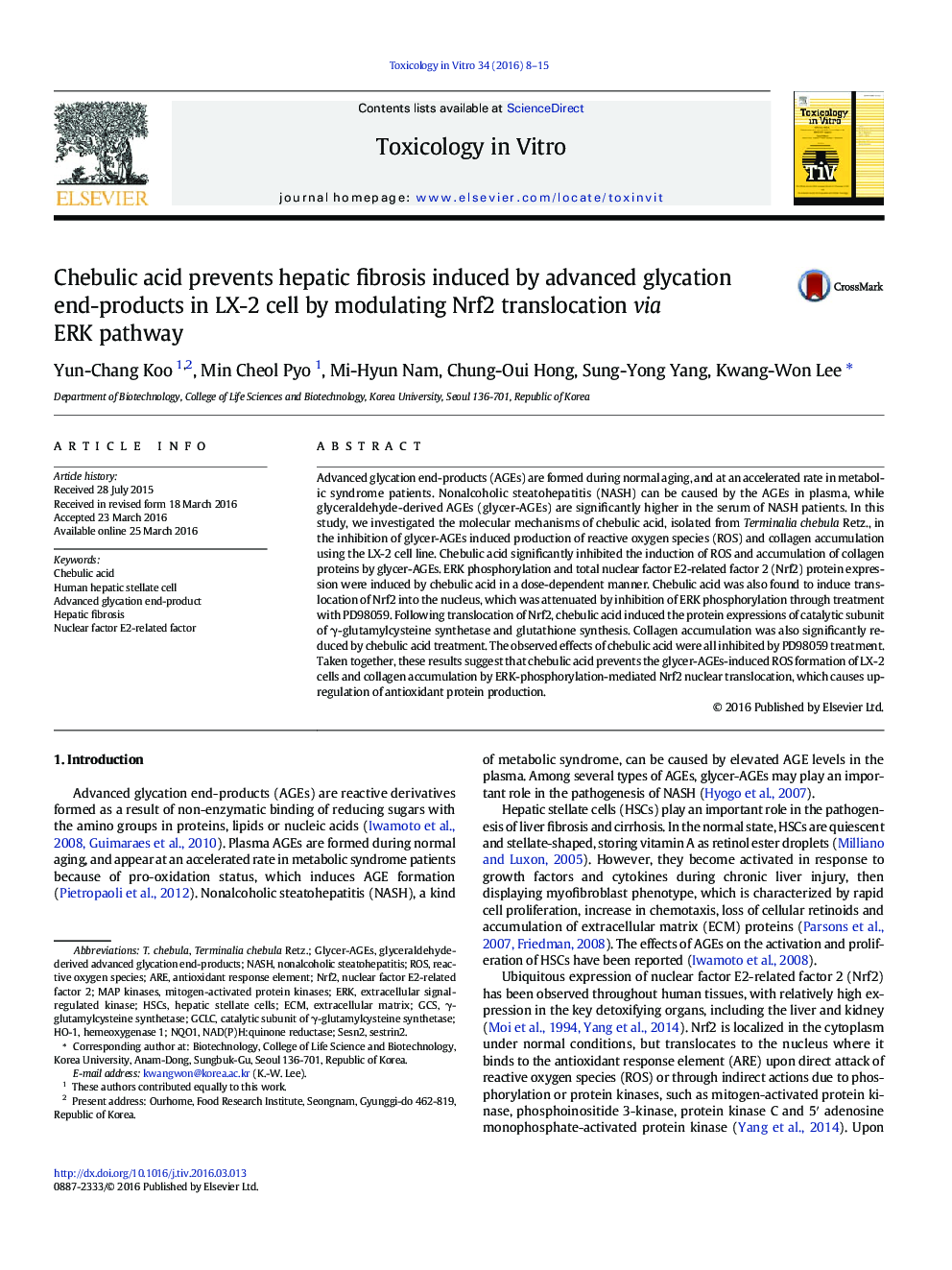| کد مقاله | کد نشریه | سال انتشار | مقاله انگلیسی | نسخه تمام متن |
|---|---|---|---|---|
| 5861066 | 1562711 | 2016 | 8 صفحه PDF | دانلود رایگان |
عنوان انگلیسی مقاله ISI
Chebulic acid prevents hepatic fibrosis induced by advanced glycation end-products in LX-2 cell by modulating Nrf2 translocation via ERK pathway
دانلود مقاله + سفارش ترجمه
دانلود مقاله ISI انگلیسی
رایگان برای ایرانیان
کلمات کلیدی
GCsNuclear factor E2-related factorNAD(P)H:quinone reductaseSesn2T. chebulaSestrin2GCLCHSCsNQO1ECMERKHO-1Nrf2ROS - ROSγ-glutamylcysteine synthetase - γ-گلوتامیل سستئین سینتاتازnonalcoholic steatohepatitis - استاتو هپاتیت غیر الکلیHepatic stellate cells - سلولهای ستارهای کبدیnuclear factor E2-related factor 2 - عامل فاکتور هسته ای E2 عامل 2antioxidant response element - عنصر پاسخ آنتی اکسیدانHepatic fibrosis - فیبروز کبدیExtracellular matrix - ماتریکس خارج سلولیAdvanced glycation end-product - محصول نهایی پیشرفته glycationNash - نوشARE - هستندHemeoxygenase 1 - هومئوکسیژناز 1MAP kinases - کیناز MAPextracellular signal-regulated kinase - کیناز تنظیم شده سیگنال خارج سلولیmitogen-activated protein kinases - کیناز پروتئین فعال MitogenReactive oxygen species - گونههای فعال اکسیژن
موضوعات مرتبط
علوم زیستی و بیوفناوری
علوم محیط زیست
بهداشت، سم شناسی و جهش زایی
پیش نمایش صفحه اول مقاله

چکیده انگلیسی
Advanced glycation end-products (AGEs) are formed during normal aging, and at an accelerated rate in metabolic syndrome patients. Nonalcoholic steatohepatitis (NASH) can be caused by the AGEs in plasma, while glyceraldehyde-derived AGEs (glycer-AGEs) are significantly higher in the serum of NASH patients. In this study, we investigated the molecular mechanisms of chebulic acid, isolated from Terminalia chebula Retz., in the inhibition of glycer-AGEs induced production of reactive oxygen species (ROS) and collagen accumulation using the LX-2 cell line. Chebulic acid significantly inhibited the induction of ROS and accumulation of collagen proteins by glycer-AGEs. ERK phosphorylation and total nuclear factor E2-related factor 2 (Nrf2) protein expression were induced by chebulic acid in a dose-dependent manner. Chebulic acid was also found to induce translocation of Nrf2 into the nucleus, which was attenuated by inhibition of ERK phosphorylation through treatment with PD98059. Following translocation of Nrf2, chebulic acid induced the protein expressions of catalytic subunit of γ-glutamylcysteine synthetase and glutathione synthesis. Collagen accumulation was also significantly reduced by chebulic acid treatment. The observed effects of chebulic acid were all inhibited by PD98059 treatment. Taken together, these results suggest that chebulic acid prevents the glycer-AGEs-induced ROS formation of LX-2 cells and collagen accumulation by ERK-phosphorylation-mediated Nrf2 nuclear translocation, which causes upregulation of antioxidant protein production.
ناشر
Database: Elsevier - ScienceDirect (ساینس دایرکت)
Journal: Toxicology in Vitro - Volume 34, August 2016, Pages 8-15
Journal: Toxicology in Vitro - Volume 34, August 2016, Pages 8-15
نویسندگان
Yun-Chang Koo, Min Cheol Pyo, Mi-Hyun Nam, Chung-Oui Hong, Sung-Yong Yang, Kwang-Won Lee,